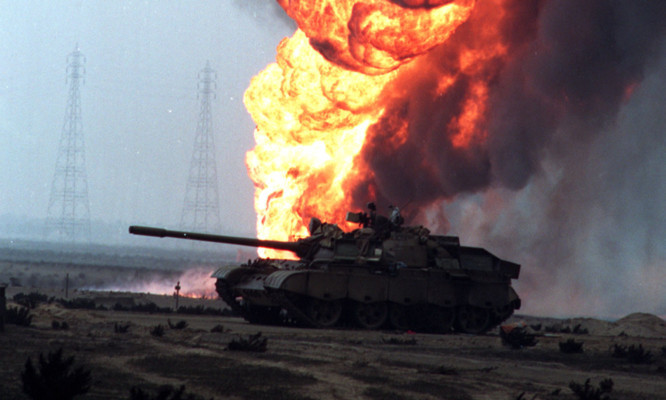A former military serviceman who fell ill without ever deploying to the Middle East has welcomed the Royal British Legion’s call for more help for veterans with so-called Gulf War Syndrome.
Former Royal Auxiliary Air Force Senior Aircraftsman Richard Sharpe took ill within days of receiving eight inoculations ahead of Operation Desert Storm in January 1991.
And he claims that senior Ministry of Defence officials tried to make out that he and others who fell ill at the time were “putting it on” as their illness prevented them from deployment.
Contacting The Courier in response to our coverage which marked the 25th anniversary since the beginning of the conflict, Mr Sharpe, now 71, of Tetbury, Gloucestershire, said: “I’m glad the British Legion have said something about it and pleased The Courier have written something about it. It’s sad though that we are having to have this conversation 25 years after the conflict. The fact I fell ill after the injections and before deployment shows that the inoculations must definitely be to blame. I would just like the Ministry of Defence to admit they got it wrong so that all those who have been ill for all these years can get the right medical treatment they deserve.”
In 1991 more than 50,000 members of the British armed forces were deployed to the Persian Gulf as part of Operation Desert Storm – a US-led campaign against the Iraqi invasion of Kuwait.
The British Legion – which provides support for veterans – said more than 60% were now suffering from illnesses related to the conflict, with nearly 10,000 receiving a war pension, the financial aid any ex-service personnel with an illness due to service can receive.
Over 33,000 former soldiers are thought to suffer from illnesses related to their service such as chronic headaches, fatigue and memory problems.
Mr Sharpe is one of them. He was serving with No. 4626 Aeromedical Evacuation Squadron, Royal Auxiliary Air Force and had a day job as warehouse manager ahead of the 1991 Gulf conflict.
Around 48 hours after receiving his jabs, he awoke with tightness across the chest and had to seek medical attention. He ended up in hospital and said he was “sent to see a psychiatrist” as most, but not all, of his colleagues deployed. He was medically discharged from the service and later discovered that several others had also taken ill. He believes the anthrax vaccine caused particular problems for many personnel.
He added: “The symptoms I experienced were my memory going, my concentration going, and it was like my brain was working in ‘slow time’ when I thought I was in ‘fast time’. The next phase is an anger phase. Like most veterans you didn’t know what is going on. I thought I was going mad. It wasn’t until there was a documentary on TV a few years later that I was ticking boxes and thinking there’s something in this! I contacted the Gulf Veterans association and said I felt like a bit of a fraud because I didn’t even go to the Gulf. But they said I was not the only one. That buoyed me up!”
The British Legion said too little was known about the condition and the government should fund more research into it.
The Ministry of Defence said it was always open to new research proposals.
Reported symptoms of Gulf War Syndrome range from chronic fatigue, headaches and sleep disturbances to joint pains, irritable bowel, stomach and respiratory disorders and psychological problems.
But the MoD says “the overwhelming consensus of the scientific and medical community” is that the range of symptoms is too broad “for this ill health to be characterised as a syndrome in medical terms”.
Confirming that it did not recognise Gulf War Syndrome, an MoD spokesperson said: “We are indebted to all those who served our country in the 1990/1991 Gulf conflict. In recognition of this financial support is available to veterans and dependants whose illness or death is due to service through the War Pensions Scheme and Armed Forces occupational pensions schemes. We are clear that veterans should not be disadvantaged as a result of their service and we are absolutely committed to supporting them and the wider Armed Forces community.”
Marie Louise Sharp, policy adviser at the Legion, said that 25 years on, more needed to be done to help ill soldiers.
“We know the health of ill Gulf War veterans continues to be an important area for the government, which is why the Legion is calling for investment into research so we can understand how to improve the lives of those affected,” she said.
“In addition, we ask for formal communication channels to be established to convey the results of US research developments to Gulf War veterans living here in the UK.”
